On the Road is a weekday feature spotlighting reader photo submissions.
From the exotic to the familiar, whether you’re traveling or in your own backyard, we would love to see the world through your eyes.
MollyS
In April 2015, my son and I went to Paris. My daughter, who’d recently moved there, was busy one cool rainy weekday, so he and I took the train to Chartres, about 60 miles southwest of Paris. The Cathédrale Notre-Dame de Chartres was built between 1020-1220 and has survived at least five fires, the French Revolution, and World War II. In 1939, the stained-glass windows were removed and hidden.
Then in August, 1944, the Allies issued a destruction order, believing the Germans were using the spires as observation posts. During the five-day battle for the town, Colonel Welborn Barton Griffith and his driver went behind enemy lines to the cathedral, reporting that there were no German troops.
The destruction order was withdrawn. Griffith retreated to nearby Lèves and commandeered a tank. He was killed that same day in the returning German rifle and rocket-launcher fire.
He was posthumously awarded the U.S. Distinguished Service Cross, and the Croix de Guerre avec Palm, the Legion of Honor, and the Legion of Merit from the French government. These are my son’s pictures as my small camera was no match for his Nikon.
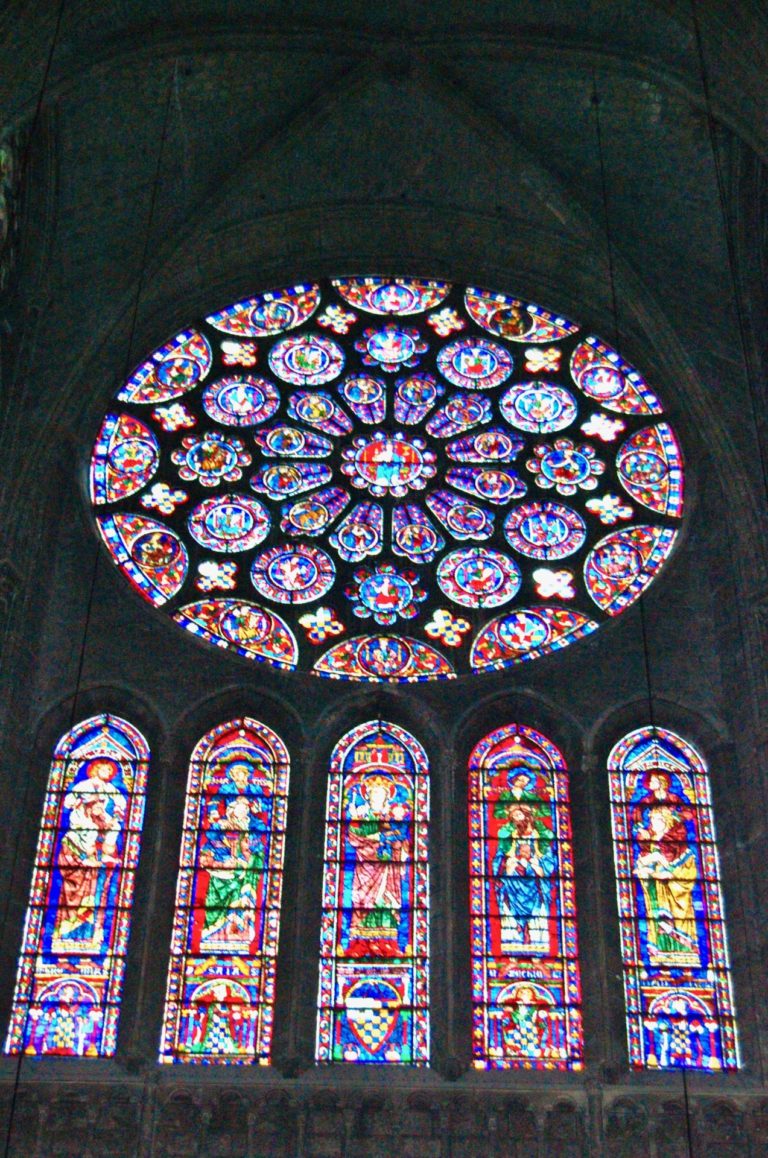
The cathedral’s South Transept rose window, crafted between 1225–1230, is 34.5 feet in diameter, and is dedicated to Christ. The five windows beneath it feature the Madonna (in the center), flanked by Luke, Matthew, John, and Mark, sitting on the shoulders of Jeremiah, Isaiah, Ezekiel, and Daniel.
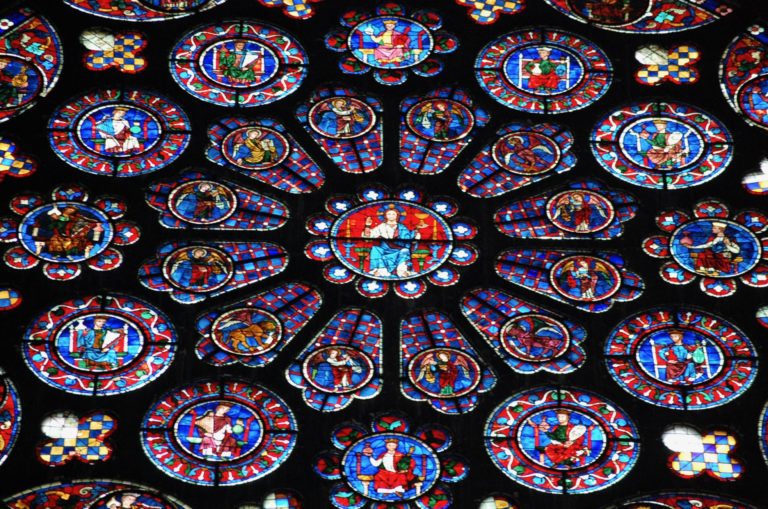
A close-up of the South Transcept rose window, with Christ in the center, surrounded by angels. The two outer rings of twelve circles feature the twenty-four Elders of the Apocalypse, carrying phials and musical instruments.

The West Portal rose window, above the cathedral’s main entrance. Dating from 1215 and 39 feet in diameter, the window depicts the Last Judgment, with Christ as Judge in the center circle. The inner ring of twelve paired circles feaures angels and the Elders of the Apocalypse. The outer ring shows the dead emerging from their tombs, while angels blow trumpets to summon them to judgment.
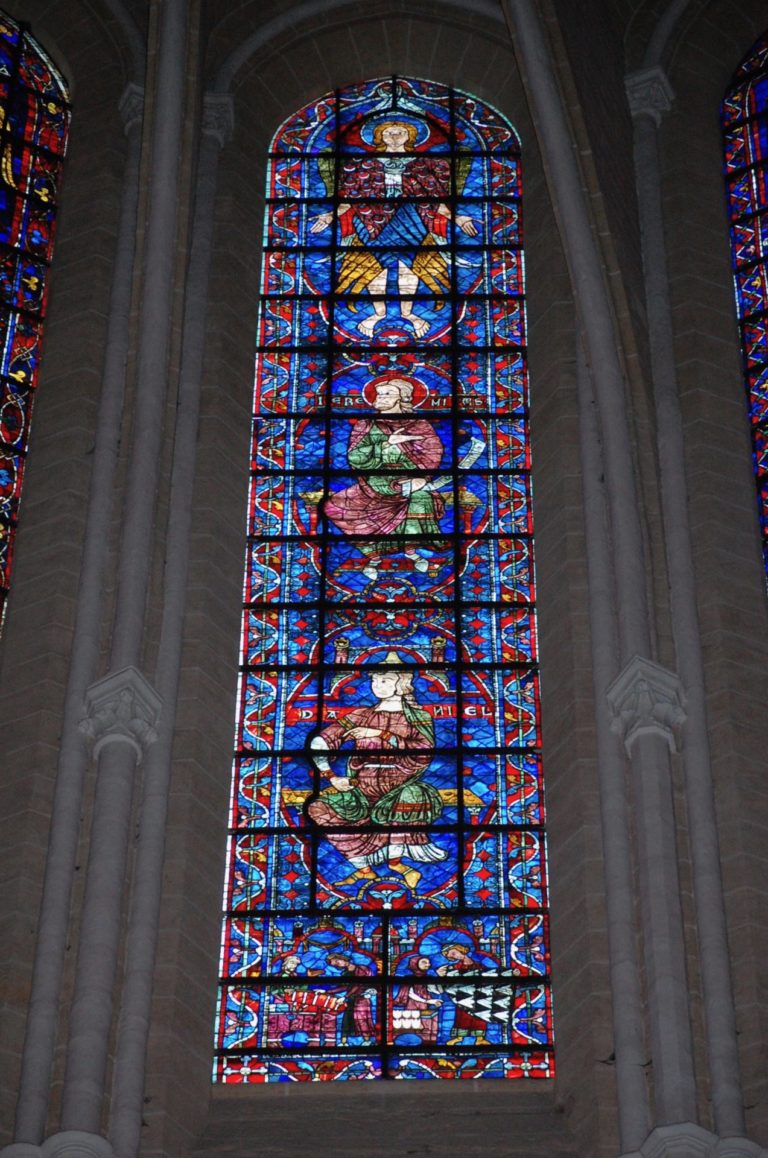
This was my son’s favorite window because the holy man is wearing a skirt made of fish. As one apparently did in the 1200s. The guard who gave us a personal tour showed him the best place to stand and aim way way way up to get the picture.
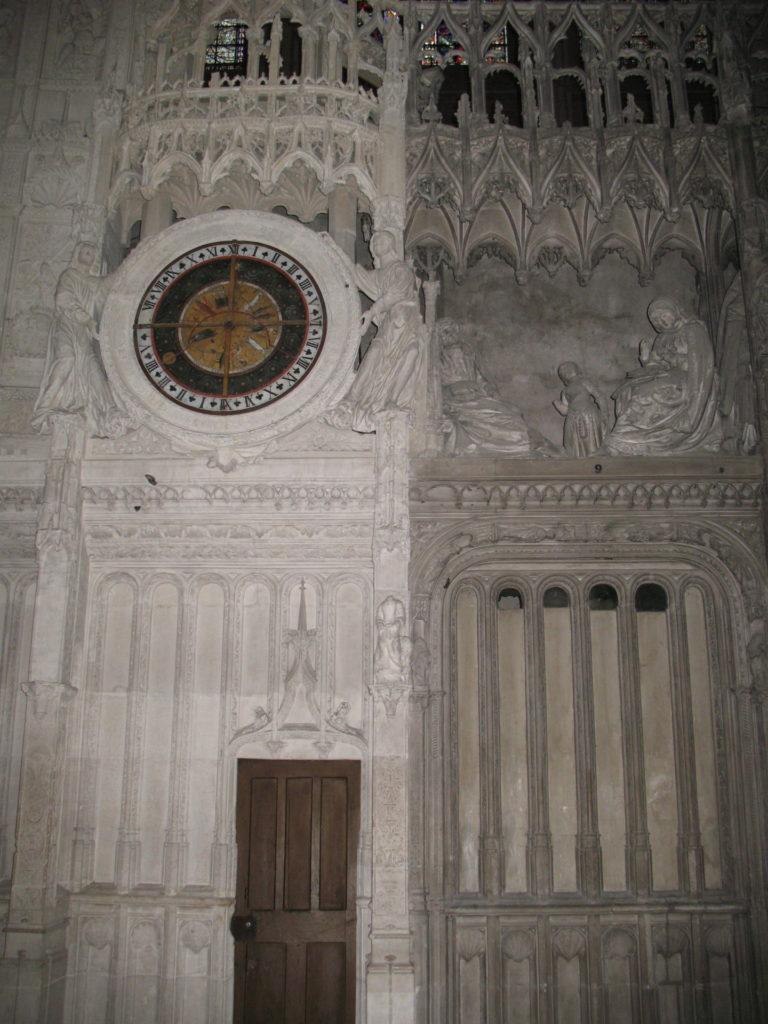
A major cleaning/restoration of Chartres Cathedral began in 1997, as 800 years of smoke and debris from candles, oil lamps, and previous fires were carefully removed from the limestone walls and ceilings, statues, and stained glass. The project was finally completed in 2018. This cleaning was controversial as many thought the building should remain in its darkened state, despite the fact that the cathedral was originally designed to be a place of light and hope, not gloom and decay.
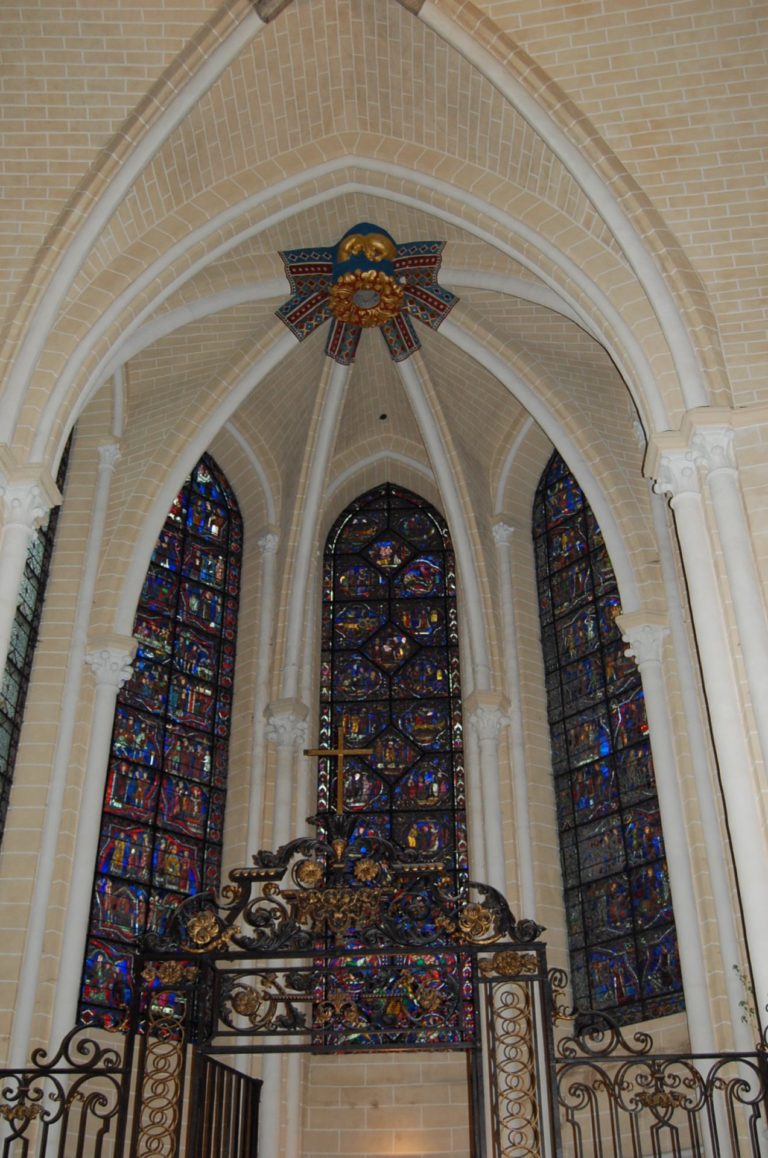
The Chapel of the Martyrs, in the Chevet (the east end of the Cathedral), has been restored to its original state.

The choir screen was added between the 16th and 18th centuries. The stone screen has forty niches with statues depicting Christ’s life. It is almost 20 feet high and about 328 feet long, and was created to separate the choir from those attending services.
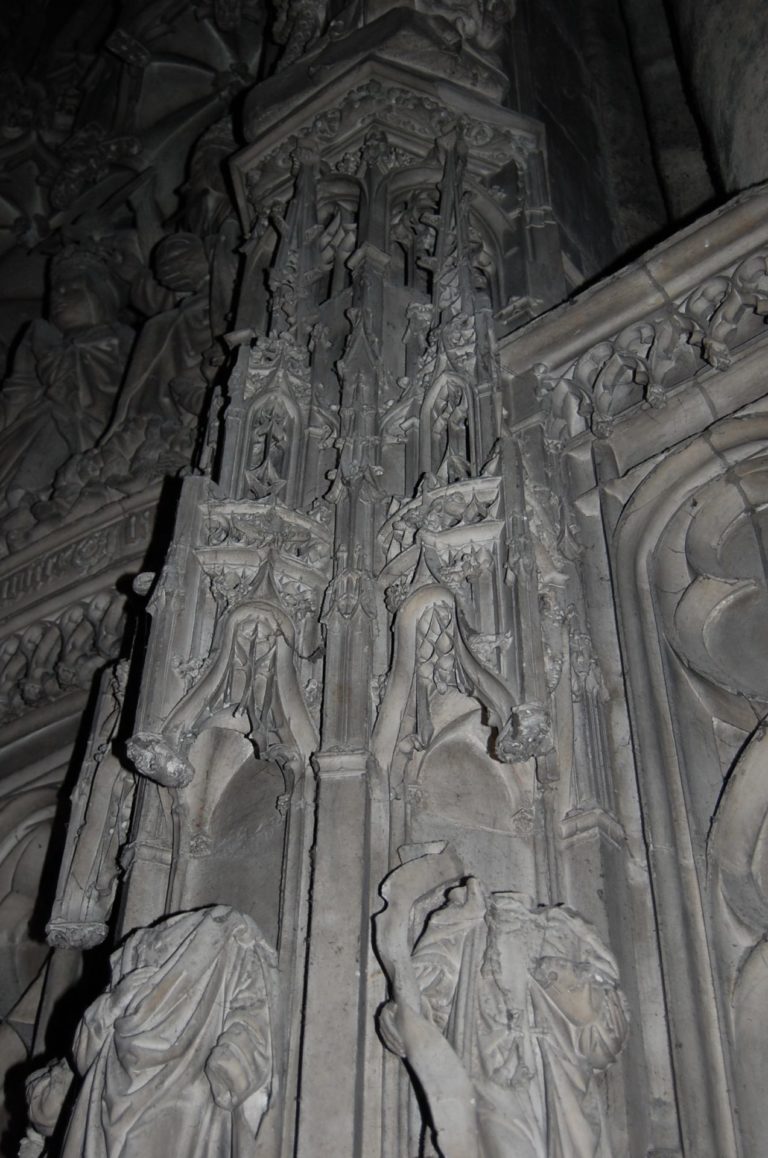
Oops … some more saints missing their heads … and only partially tidied up.
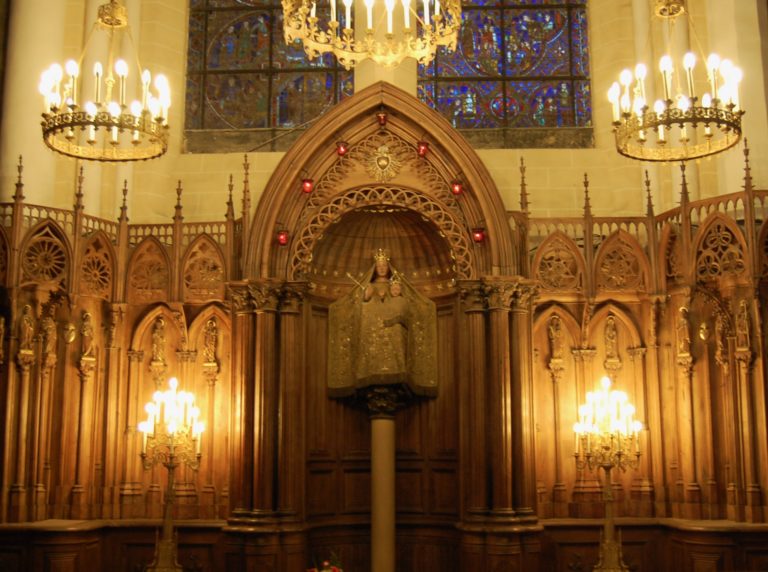
Because this April day was cloudy and rainy, much of the cathedral’s interior was dark. But several of the more important icons and reliquaries were well-lit. One of the most controversial restorations is the (formerly) Black Madonna. Her skin darkened by centuries of smoke and dirt, the Black Madonna was a focal point in the cathedral for thousands of pilgrims. But she was dramatically transformed after cleaning. Again, this restoration was faithful to the original statue. As the New York Times pointed out, the statue was commissioned as a copy of an earlier Madonna named Notre Dame la Blanche … or Our White Lady.
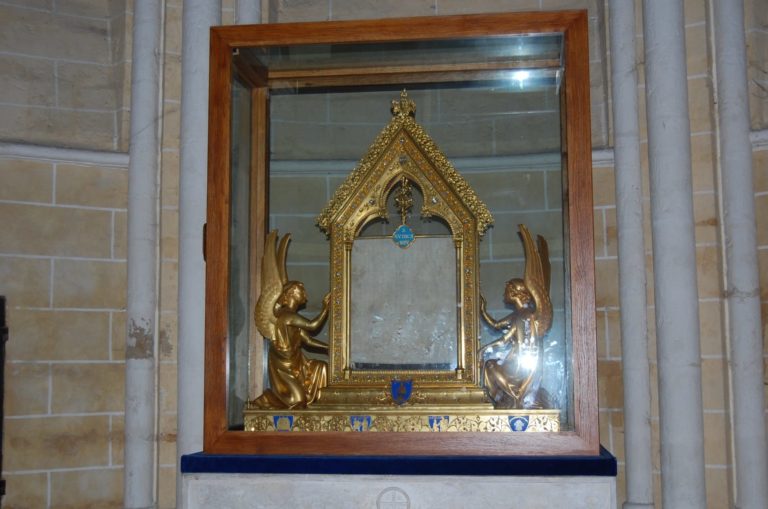
Mary’s veil has been venerated at Chartres since 876 after Charles the Bald gave the church fathers the relic he’d inherited from Charlemange, his grandfather. The veil was (supposedly) worn by Mary on the day of the Annunciation. During the Revolution, the cloth was removed from the cathedral and cut into several pieces. Today the only remaining piece is in this reliquary, specially designed to protect against humidity and light. And thieves.

Lapassionara
Wonderful photos. Thank you. I was just stunned when I first saw Chartres from the train, as it is so big it dominates the landscape. I had not heard that the towers were to be bombed during the liberation of France. What a story and what a hero.
Auntie Anne
These are fabulous pictures! So lovely to see the windows!
HumboldtBlue
Absolutely stunning. Great photos, lovely post.
Benw
Damn those are some amazing pics and that’s a hell of a story!
randy khan
Oh, oh, oh, the stained glass!
Reliquaries fascinate me. The gold, silver, and gems used to house ordinary (and often kind of gruesome) objects as a form of veneration, and the idea that what’s inside is more precious than the most precious container really are intriguing.
JanieM
Beautiful pictures. Love the skirt made of fish.
Every one of these posts make me want even more to go to France.
debbie
@Lapassionara:
What a loss, if not for Colonel Griffith!
dexwood
Wow! The pictures and the story. Thanks.
Yutsano
Music like this was made for such lovely venues.
Omnes Omnibus
I am pretty sure it was a fish kilt.
sstarr
Brings back great memories of my visit in the 90’s. Thanks!
Kristine
Stunning photos! Thank you for posting them and providing the backstory.
BigJimSlade
Hey @MollyS! Thanks for posting these!
The stained glass at Chartres is notoriously hard to photograph. To me, anyway. I was there in ’89 with a Vivitar 110 soap bar (more like 2 soap bars stuck together end-to-end). What I found was that all the details (soooo many details!) were far up and away and surprisingly small. And then there’s the dynamic range issue with light coming through the glass, right next to dark walls. But such lovely blue and red.
And seeing the cathedral as you approach the town is wonderful!
I think the Notre Dame de Paris (may it be restored successfully, incha FSM) is my favorite building in the world (I hate picking favorites), but Chartres and Ste. Chapelle aren’t far behind.
Dammit, I’m going to have to go buy/eat some Camembert.
BigJimSlade
@BigJimSlade: When my wife and I don’t want to hike EVERY day of our vacations, I’m going back!
Soprano2
@Yutsano: Oooh, John Rutter is far and away my favorite choral composer. He writes music that’s an absolute joy to sing. His “Requiem” is one of my favorite pieces of choral music. I hope to sing it again someday. I’ve never sung his “Magnificat”, though.
Those pictures are beautiful. Thanks for them, they’re much better than the ones I took so long ago.
CaseyL
Thank you for a gorgeous post and photos!
The perfection and glorious colors of the stained glass at Chartres (and Notre Dame) makes me wonder so much about the artisans who created them, and their techniques. Did they do anything different from how stained glass is made today? What formulas did they use to produce those pigments? And so on…
Mary G
Makes me feel slightly more positive about the world that we have managed to keep this beautiful place going for more than 800 years. I had never heard about the near miss in WWII, glad it was averted.
These are unusually nice photos of the stained glass, with much better detail than a lot I’ve seen.
Mary G
O/T but cute animals:
opiejeanne
@CaseyL: I don’t think we know exactly how they produced the colors in glass back then. I worked in a stained glass shop for a few years, restoring Tiffany windows and making new projects for clients, and I know that modern glass isn’t quite as vibrant. Red or orange glass is produced using gold.
Betty
The artisanship is truly amazing. That stone screen alone is a marvel. So beautiful.
sab
Wow. Somewhere else I need to see again. So Chartres many years ago. I hadn’t thought of it as drab from smoke, but that makes sense. I would love to see it as the builders intended it.
But they cleaned up Yorkminster, and God hit it with lightning. So there is that.
francophile
The window depicting a man wearing fish is actually shows the prophets Daniel at the bottom and Jeremiah in the middle. The top figure is actually a cherubim. The fish are the feathers of his folded wings.
https://www.therosewindow.com/pilot/Chartres/w104.htm
Elizabelle
Thanks for your beautiful photos. Got to see Chartres, and before too long.
A guide to several French gothic cathedrals that are day trips from Paris (looks like a good blog).
The NY Times article on Chartres’ “controversial” restoration. I am glad to see the cathedral closer to as it appeared when new. There is no end of time-gloomed architecture in Europe. I wonder if we will see the fully cleaned and restored interior of Notre Dame de Paris in our lifetime; maybe there will be a lot of discussion of how to handle that, beyond removing the fire and smoke destruction.
randy khan
@Elizabelle:
I love “not monuments to melancholy”!
A lot of the architecture of the time was about bringing light into the buildings, so you know that they didn’t want them to be gloomy. One of the big reasons for flying buttresses was to allow buildings to have more windows.
Kayla Rudbek
@Elizabelle: I love how modern science can pick up the remnants of the colors that were there.
Kayla Rudbek
@opiejeanne: different sources of the materials for the glass, or more contamination of modern materials, or more refined materials in modern times than back then? Or maybe different temperature or less evenly applied heat in medieval times?
Elizabelle
@randy khan: @Kayla Rudbek:
It’s thrilling to live in a time when restorations can turn out way better than Ecce Homo in Spain a few years ago.
I loved that comment about “not monuments to melancholy” too.
MollyS
@francophile: Merci!
MollyS
Thanks to all who praised my son’s photos … I’ve passed the compliments on to him. I’m looking forward to returning to Paris (this fall, please …) and do plan to go back to Chartres, on a sunny day. I do think the people who labored for two centuries to build this cathedral would be grateful that it’s finally restored to its original glory, rather than being coated in dirt and grime!